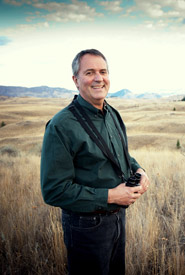40 years of adventures at Lac du Bois
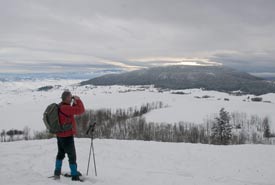
Ian Barnett surveys the landscape at Frolek Ranch, Lac du Bois, BC (Photo by Brendan Matthews)
In the mid-1990s much of the grasslands and open forests situated near my home in Kamloops, BC were made a provincial park due to the unique flora and fauna present and the need to conserve shrinking native grassland habitat in BC. In 2008, the Nature Conservancy of Canada (NCC) bought 2,342 acres (948 hectares) of private land from the Frolek Ranch to augment the adjacent park land. The result has become a magnificent landscape of over 37,000 acres (14,980 hectares) conserved in perpetuity — the Lac du Bois Conservation Area.
I first ventured into this treasure of natural bounties circa 1977. In fact, I was at work undertaking vegetation transects atop Opax Mountain, which looks over the [then] Frolek Ranch, when I heard the news that Elvis Presley had died. It was very curious, as my boss for my summer job, who was a very religious and austere scientist (and not a music fan in the least) made a very rare visit to our research site to inform us of this news!
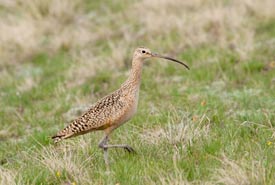
Long-billed curlew (Photo by Brendan Matthews)
As a young man, I was quite taken with the area. In a bid to impress my girlfriend (and now spouse), I took her camping to Lac du Bois that same summer. I recall that we forgot to pack water and in a naive effort to save face, I proclaimed that we could drink the lake water if we boiled it. Well, it soon became apparent that I was dead wrong as the methane gas began to permeate the air. When we took it off the stove, the pot was caked with white precipitate from magnesium, sodium and lithium salts.
In the mid-1980s, I was banding waterfowl at Lac du Bois, and invited my neighbour and his two young boys to help. As we were trying to drive a flock of flightless lesser scaup with a boat into a netted corral, I turned the 1.5-horsepower motor too quickly and one of the boys flew out into the highly eutrophic water! After an awkward flurry of movement we managed to pull him aboard covered with aquatic vegetation. When he was back at school that fall he wrote about what he did on his summer vacation and entitled it his “closest encounter with death”!
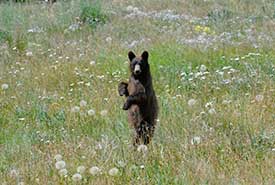
Black bear (Photo by Brendan Matthews)
One Halloween night in the early 1990s, while watching fireworks on the hillside above my house and mixing candy with beer, I received a call from one of the ranchers and water users at Lac du Bois. We had cooperated to install a small irrigation and conservation water control structure at the outlet of a wetland and he informed me that there were some partiers who had taken a chainsaw to the boards that held the water back and were draining the lake. So we went up together in his truck. In his soft-spoken yet tough discourse, the rancher soon had the group scurrying off in all directions. I think the presence of a John Wayne-style 30/30 rifle in the gun rack of the truck, which was a legal means of firearms transport then and used for emergency livestock issues, helped prevent any quarrels.
Over the past 15 years, I have criss-crossed much of the Lac du Bois area on foot, skis, snowshoes, canoe and horse. A close friend often joins me, and has become a very accomplished photographer. We have witnessed some wonderful sightings, including almost running over a pair of long-billed curlew and seeing 23 sharp-tailed grouse being pursued by a gyrfalcon diving headfirst into a metre of snow. Often when we take a trip and see interesting wildlife, my photographer friend returns by himself to take photos by the hour.
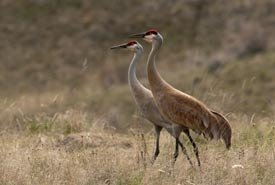
Sandhill cranes (Photo by Brendan Matthews)
Recently he very kindly donated to NCC a large number of his best photos taken in these grasslands. These include a prairie falcon attacking a sharp-tailed grouse, dancing grouse in a lek, Lewis’s woodpecker at a nest site, sandhill cranes overhead and many lovely vistas. Wolves have increased in the area over the past few years and we took several winter expeditions to try and capture some photos of them.
A year ago my wife and I were snowshoeing at Lac du Bois with our nine-month pregnant daughter and her partner. I separated from the group to explore a new trail, and shortly after my Blackberry rang with the news that I must return as she was commencing her labour. It was a good thing that we had phones, as I had the car keys or little Rhys may have been born beside a fire, under a Douglas fir tree and overlooking the lovely glacier-shaped grassland landscape!
Although I like to think of this vast area as my “backyard fiefdom,” I am delighted to see an increase in people who use Lac du Bois Conservation Area and take obvious pleasure in exploring its grandeur. Walking, skiing, snowshoeing, photography and nature viewing are all becoming more popular. A number of geocache sites have been set up in the park and NCC lands.
Although it's just 10 kilometres away from a city of 90,000 people, the Lac du Bois Conservation Area provides an ideal opportunity to connect Canadians to nature and the great outdoors.

